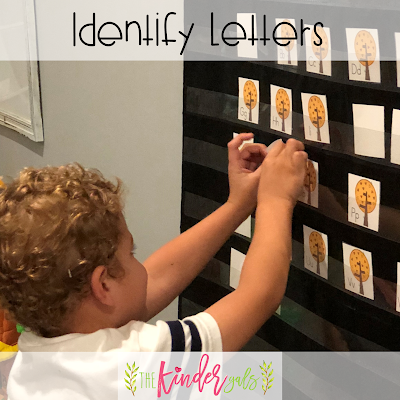1. Poem
This poem has quite a story....I dreamed it! I woke up and typed it in my phone because I knew I wouldn't remember it in the morning! The teacher dreams...we all have them.- First, I typed the sentences and printed them on white cardstock.
- I made the 4 picture cards to sequence.
- Then, I made each sentence on a different color of cardstock.
- This makes it easy for kids to know which words go together.
To play:
- The kids sequence the pictures.
- Using their reading powers, they match the sentences to the pictures.
- Now, they build each sentence by placing the colored cardstock words over the white cardstock words.
As a follow up, the kids can make this "The Scarecrow" book. To make the book:
- Staple the cover to 4 blank pages.
- Invite the children to cut and sequence the pictures.
- Glue one picture on each page.
- Cut the 4 sentences apart.
- Using the pocket chart work, the kids glue the correct sentence with each picture.
- Invite kids to place this in their bag of books to read again and again!
You could also use the poem all on one page. Invite children to add the poem to their poetry journal.
2. Sorting
To develop vocabulary (naming pictures), we created a sorting center. To play:
- The kids, or you, select the sorting cards to place at the top of the pocket chart.
- Then, they sort the picture cards into the correct category.
It is always acceptable for kids to create their own sorting strips to put at the top!
To record their work, the kid write the different ways they sorted the cards. After their final sort, they select one of the ways to illustrate.
3. Rhyming (phonemic awareness)
To play the rhyming game:
- Invite the kids to put the baskets in the pocket chart.
- Spread the acorns on the floor or place along the bottom of the pocket chart.
Invite the kids to select the acorns and find the basket with the rhyming word.
Using the pocket chart work, the kids can complete the recording sheet. It doesn't have all of the matches, but it has enough to determine if they understand rhyming words.
4. Word Making
To get ready:
- Invite the kids to make a column of the pictures.
- Match the word cards to the pictures.
- Using the individual letters, invite the kids to make each word.
We are making the words by using the word cards. But, if you kids are ready to stretch words, you may want to eliminate the word cards.
5. Sound Matching (Phonics)
To begin the game:
- Place the word cards in the pocket chart.
- Place the letters along the bottom of the pocket chart.
Invite the kids to name the picture and find the beginning letter. Place the letter in the box beside the picture.
On the recording page, the children cut apart the letters and match them to the correct picture. Not all of the pictures are on the recording page, but there are enough for you to check their work.
6. Find the.... (Letter Identification)
To get ready:
- Place the letters in abc order. Create an array.
- Hide the crow behind one of the letters.
To Play:
- Invite the children to take turns identifying a letter.
- As they name the letter, they look behind to see if the crow is hiding there.
- Turn the card over so that we will know we already looked there.
The object of the game is to find the crow hiding behind one of the letters.
Give each child a recording page. As the letter is turned over, invite the kids to place a chip on the letter. This gives every child a chance to identify the letter. The last time you play, you may want to let kids use a bingo dotter!
All of these activities are included in our Pocket Chart Activities for Fall Unit.









































































